Research on the Application Decision Making of Information Technology in the Sustainable Supply Chain of Cross-Border E-Commerce
Abstract
1. Introduction
2. Literature Review
3. Methods and Modeling
3.1. Methods
3.2. Modeling
- The dual-channel products are identical. Specifically, the product from Merchant 1 is the same as that from Merchant 2. This assumption is adopted to focus on the competition in service differentiation rather than product attributes, as the core of this research lies in exploring how IT-enabled service differentiation influences supply chain decisions and performance. By abstracting away product attribute differences, we can more clearly observe the role of service quality in driving consumer choice and merchant competition.
- Consumers are assumed to be rational actors who make purchasing decisions based on utility maximization. This assumption is grounded in the reality of e-commerce environments, where consumers typically have access to ample product and service information. Rational consumer choice provides a solid foundation for formulating demand functions and analyzing market equilibrium. It enables us to model consumer responses to different service and pricing strategies, thereby offering insights into how merchants can optimize their decisions to attract consumers and enhance profitability.
- Without loss of generality, both merchants are assumed to confront unit market demand and only account for service costs, with other costs being zero. This assumption reflects the characteristics of cross-border e-commerce, particularly in scenarios involving digital services and information-based offerings. In such contexts, once the initial setup is complete, the marginal cost of replicating and delivering digital services is negligible. By focusing on service costs, we can isolate the impact of service differentiation on supply chain decisions and profitability, providing a clearer understanding of the strategic value of IT investments in enhancing service quality.
3.3. Centralized Decision in the Supply Chain (CD)
3.4. Decentralized Decision in the Supply Chain (DD)
4. Equilibrium Analysis and Inference
4.1. The Impacts on the Service Level
4.2. The Impacts on the Profit
5. Numerical Analysis
5.1. The Numerical Analysis Related to the Service Differentiation
5.1.1. Service Differentiation and Consumer Preferences
5.1.2. Service Differentiation and Consumers’ Sensitivity
5.1.3. Service Differentiation and Service Cost Coefficient
5.2. The Numerical Analysis Related to the Profit
5.2.1. Overall Profit and Consumers’ Sensitivity
5.2.2. Overall Profit and Service Cost Coefficient
5.2.3. Overall Profit and Service Differentiation
6. Conclusions
Author Contributions
Funding
Data Availability Statement
Conflicts of Interest
Abbreviations
| CBEC | Cross-border E-commerce |
| IT | Information Technology |
| CC | Centralized Decision |
| DC | Decentralized Decision |
Appendix A
Appendix A.1. The Derivation Process of Consumer Utility Function
- 1.
- When , which implies that , the consumers will not make a purchase from either Merchant 1 or Merchant 2, as the utility derived from the purchase would be negative;
- 2.
- When and , which indicates that and , the consumers are more inclined to purchase from Merchant 1, as this offers a higher utility, while Merchant 2 would not receive any purchases;
- 3.
- When and , which implies that and , the consumers are more likely to purchase from Merchant 2, as this provides a higher utility, while Merchant 1 would not receive any purchases;
- 4.
- When , which means that and , the consumers are indifferent between purchasing from Merchant 1 or Merchant 2, as the utilities are the same.
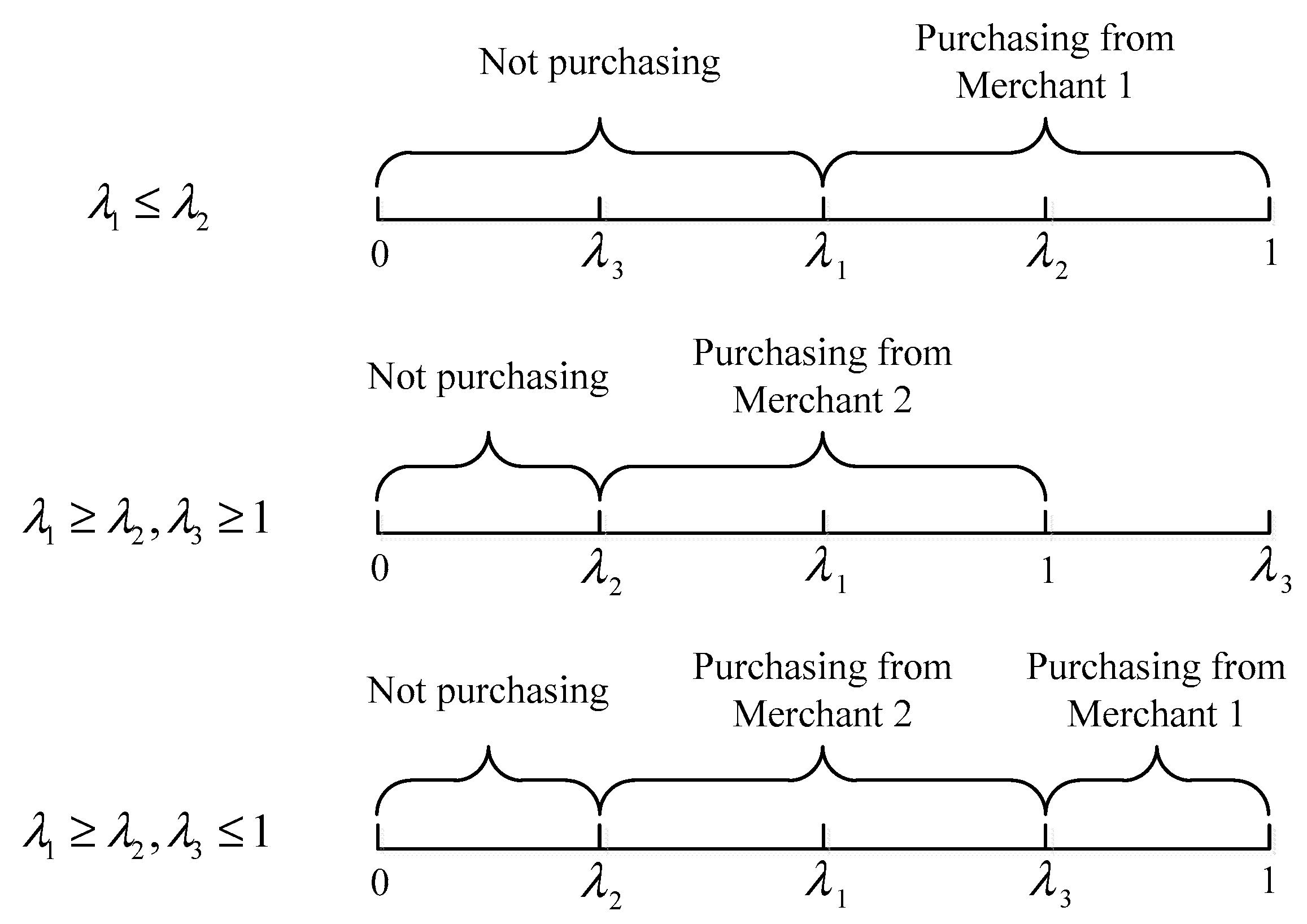
- 1.
- In case , it follows that ; consumers do not make purchases from Merchant 2, resulting in a demand of . When , consumers purchase from Merchant 1, with the demand expressed as ; when , no purchase behavior occurs. As a result, the price range satisfies the following conditions.
- 2.
- In cases and , consumers do not make purchases from Merchant 1, leading to a demand of . When , consumers purchase from Merchant 2, with the demand given by ; when , no purchase behavior takes place. Consequently, the price range adheres to the subsequent conditions.
- 3.
- In cases and , when , consumers purchase from Merchant 1, and the demand is ; when , consumers purchase from Merchant 2, with the demand calculated as . As a result, the price range complies with the following conditions.
Appendix A.2. The Solution Process of Optimal Strategy in CD Scenario
Appendix A.3. The Solution Process of Optimal Strategy in DD Scenario
References
- Marketdataforecast. Global Cross Border E-Commerce Market—Size, Share, Trends, & Growth Forecast Report. Available online: https://www.marketdataforecast.com/market-reports/cross-border-e-commerce-market (accessed on 15 June 2024).
- Xinhua. China’s Foreign Trade Hits New High in 2024. Available online: https://english.www.gov.cn/archive/statistics/202501/13/content_WS6784a546c6d0868f4e8eec59.html (accessed on 13 January 2025).
- Fei, X. Driving economic transition: The impact of cross-border e-commerce policy on the upgrading of service industry structure. Econ. Anal. Policy 2024, 84, 941–956. [Google Scholar]
- Sun, X.; Huang, Q.; Zhang, H.; Zhao, X. Comprehensive pilot zones for cross-border E-commerce propel the digital transformation of manufacturing enterprises: New evidence from China. In Electronic Commerce Research; Springer: Berlin/Heidelberg, Germany, 2024. [Google Scholar]
- Zhu, J. Application Analysis of Artificial Intelligence Technology in the Development of Cross-border E-commerce. In Proceedings of the AIAM2021: 2021 3rd International Conference on Artificial Intelligence and Advanced Manufacture, Manchester, UK, 23–25 October 2021; pp. 1112–1116. [Google Scholar]
- Qin, X.L.; Liu, Z.X.; Yang, Z.; Tian, L. Carbon footprint reduction in an e-commerce market: Impacts of logistics service sharing. Omega 2025, 131, 103205. [Google Scholar] [CrossRef]
- Gong, C.; Song, H.; Chen, D.; Day, S.J.; Ignatius, J. Logistics sourcing of e-commerce firms considering promised delivery time and environmental sustainability. Eur. J. Oper. Res. 2024, 317, 60–75. [Google Scholar] [CrossRef]
- Cheah, L.; Huang, Q. Comparative carbon footprint assessment of cross-border e-commerce shipping options. Transp. Res. Rec. 2022, 2676, 584–595. [Google Scholar] [CrossRef]
- Feng, Y. Green progress of cross-border e-commerce industry utilizing random forest algorithm and panel Tobit model. Appl. Artif. Intell. 2023, 37, 2219561. [Google Scholar] [CrossRef]
- Yang, Y.; Chen, N.; Chen, H. The Digital Platform, Enterprise Digital Transformation, and Enterprise Performance of Cross-Border E-Commerce-From the Perspective of Digital Transformation and Data Elements. J. Theor. Appl. Electron. Commer. Res. 2023, 18, 777–794. [Google Scholar] [CrossRef]
- Zhu, Q.; Ruan, Y.L.; Liu, S.; Yang, S.; Wang, L.; Che, J.H. Cross-border electronic commerce’s new path: From literature review to AI text generation. Data Sci. Manag. 2023, 6, 21–33. [Google Scholar] [CrossRef]
- Elia, S.; Giuffrida, M.; Mariani, M.M.; Bresciani, S. Resources and digital export: An RBV perspective on the role of digital technologies and capabilities in cross-border e-commerce. J. Bus. Res. 2021, 132, 158–169. [Google Scholar] [CrossRef]
- Zhao, L.; Wan, Y. A Study of Cross-Border E-Commerce Supply Chain Research Rrends: Based on Knowledge Mapping and Literature Analysis. In Proceedings of the 2024 IEEE 6th Advanced Information Management, Communicates, Electronic and Automation Control Conference (IMCEC), Chongqing, China, 24–26 May 2024; pp. 1944–1955. [Google Scholar]
- Wang, W. A IoT-Based Framework for Cross-Border E-Commerce Supply Chain Using Machine Learning and Optimization. IEEE Access 2024, 12, 1852–1864. [Google Scholar] [CrossRef]
- Chen, C.F. The Development Dilemma and Countermeasures of Chinese Cross-border E-commerce Enterprises Under the Background of Big Data. J. Comput. Methods Sci. Eng. 2023, 23, 1087–1099. [Google Scholar] [CrossRef]
- Tiwari, S.; Sharma, P.; Choi, T.M.; Lim, A. Blockchain and third-party logistics for global supply chain operations: Stakeholders’ perspectives and decision roadmap. Transp. Res. Part E Logist. Transp. Rev. 2023, 170, 103012. [Google Scholar] [CrossRef]
- Ran, J.F.; Ma, H.; Ran, R.Y. The Role of Big Data and IoT in Logistics Supply Chain Management of E-commerce. J. Comput. Methods Sci. Eng. 2024, 24, 813–822. [Google Scholar] [CrossRef]
- Yuan, L.; Zhuojim, Z.; Mingzhu, Z.O.; Ziqi, L. How does digital trade impact urban carbon emissions efficiency? Evidence from China’s cross-border e-commerce pilot zones. J. Clean. Prod. 2024, 456, 142363. [Google Scholar]
- Barata, F.A. Information technology Mediating Influence Supply Chain Management on Competitive Advantage at PT. Ritelteam Sejahtera Indonesia. Qual.-Access Success 2022, 23, 217–223. [Google Scholar]
- Dallocchio, M.; Lambri, M.; Sironi, E.; Teti, E. The Role of Digitalization in Cross-Border E-Commerce Performance of Italian SMEs. Sustainability 2024, 16, 508. [Google Scholar] [CrossRef]
- Qu, C.; Kim, E. Reviewing the Roles of AI-Integrated Technologies in Sustainable Supply Chain Management: Research Propositions and a Framework for Future Directions. Sustainability 2024, 16, 6186. [Google Scholar] [CrossRef]
- Kouhizadeh, M.; Sarkis, J. Blockchain technology and the sustainable supply chain: Theoretically exploring adoption barriers. Int. J. Prod. Econ. 2021, 231, 107831. [Google Scholar] [CrossRef]
- He, Y.; Wang, Z.; Liu, S.; Du, X. Construction and implementation of cross-border e-commerce supply chain system under the background of green and low-carbon. J. Internet Digit. Econ. 2024, 4, 1–11. [Google Scholar] [CrossRef]
- Karhade, P.P.; Dong, J.Q. Information Technology Investment and Commercialized Innovation Performance: Dynamic Adjustment Costs and Curvilinear Impacts. MIS Q. 2021, 45, 1007–1024. [Google Scholar] [CrossRef]
- Nour, R. Enhancing the Logistics 4.0 Firms through Information Technology. Sustainability 2022, 14, 15860. [Google Scholar] [CrossRef]
- Zhou, F.L.; Zhang, C.C.; Chen, T.F.; Lim, M.K. An evolutionary game analysis on blockchain technology adoption in cross-border e-commerce. Oper. Manag. Res. 2023, 16, 1766–1780. [Google Scholar] [CrossRef]
- Wang, L.H.; Wang, H.Y.; Huang, M.; Dai, W. The impacts of blockchain adoption in fourth party logistics service quality management. Int. J. Ind. Eng. Comput. 2024, 15, 737–754. [Google Scholar] [CrossRef]
- Zhang, R.; Xia, Z.W.; Liu, B. Optimal Pricing Decisions for Dual-Channel Supply Chain: Blockchain Adoption and Consumer Sensitivity. Complexity 2022, 2022, 4605455. [Google Scholar] [CrossRef]
- Zhao, L. Blockchain adoption and contract coordination driven by supplier encroachment and retail service: An analysis from consumers’ information traceability awareness. Technol. Soc. 2023, 73, 102237. [Google Scholar] [CrossRef]
- Modak, N.M.; Senapati, T.; Simic, V.; Pamucar, D.; Saha, A.; Cárdenas-Barrón, L.E. Managing a sustainable dual-channel supply chain for fresh agricultural products using blockchain technology. Expert Syst. Appl. 2024, 244, 122929. [Google Scholar] [CrossRef]
- Zhou, K. Financial model construction of a cross-border e-commerce platform based on machine learning. Neural Comput. Appl. 2023, 35, 25189–25199. [Google Scholar] [CrossRef]
- Zhang, Z.Y.; Yu, L.Y. Research on optimal pricing decisions of the service supply chain oriented to strategic consumers. J. Ind. Manag. Optim. 2023, 19, 3509–3553. [Google Scholar] [CrossRef]
- Hamzaoui, A.F.; Turki, S.; Rezg, N. Unified strategy of production, distribution and pricing in a dual-channel supply chain using leasing option. Int. J. Prod. Res. 2024, 62, 7167–7185. [Google Scholar] [CrossRef]
- Liu, X.; Du, W.; Olasehinde, T.; Fan, Y. Balancing competition and sustainability: Strategic supply chain configurations in response to consumer low-carbon preferences. Sustain. Futures 2025, 9, 100411. [Google Scholar] [CrossRef]
- Ali, S.M.; Rahman, M.H.; Tumpa, T.J.; Rifat, A.A.M.; Paul, S.K. Examining price and service competition among retailers in a supply chain under potential demand disruption. J. Retail. Consum. Serv. 2018, 40, 40–47. [Google Scholar] [CrossRef]
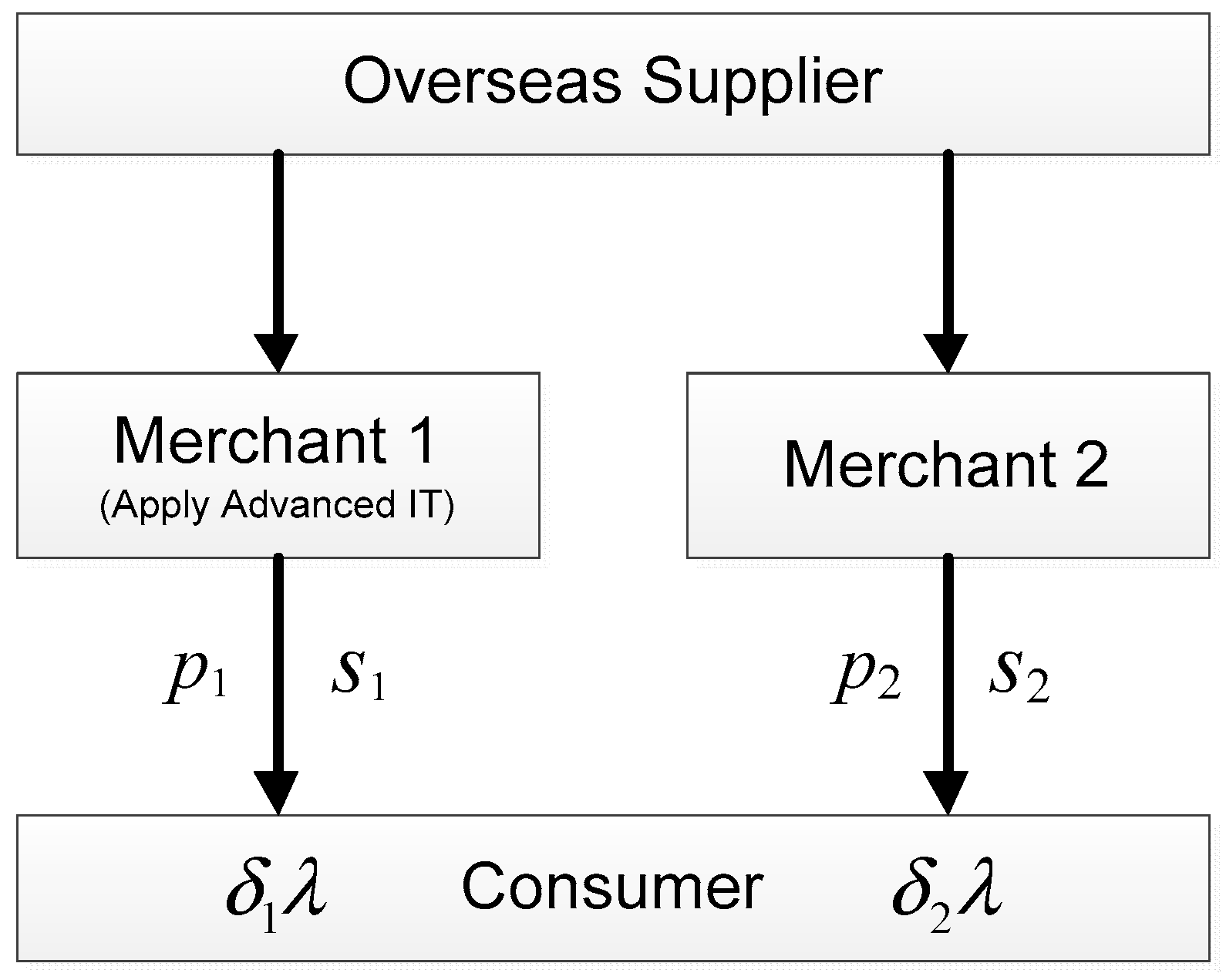
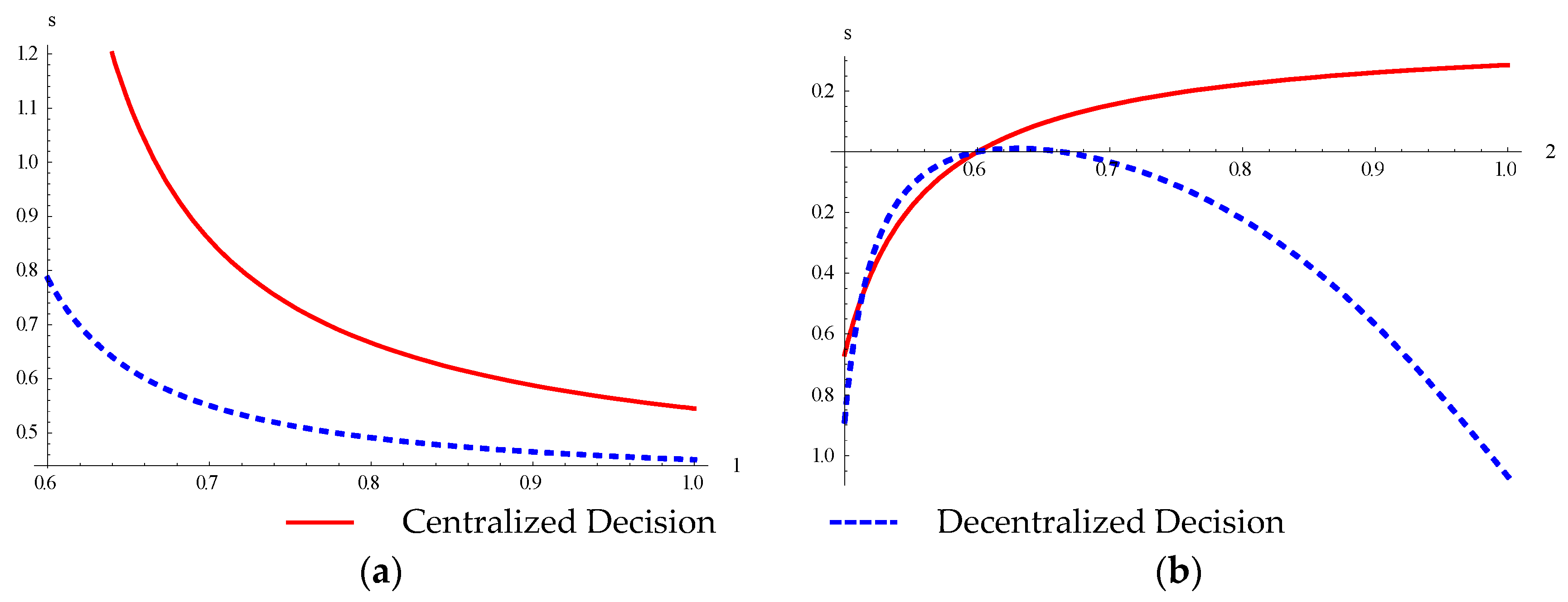
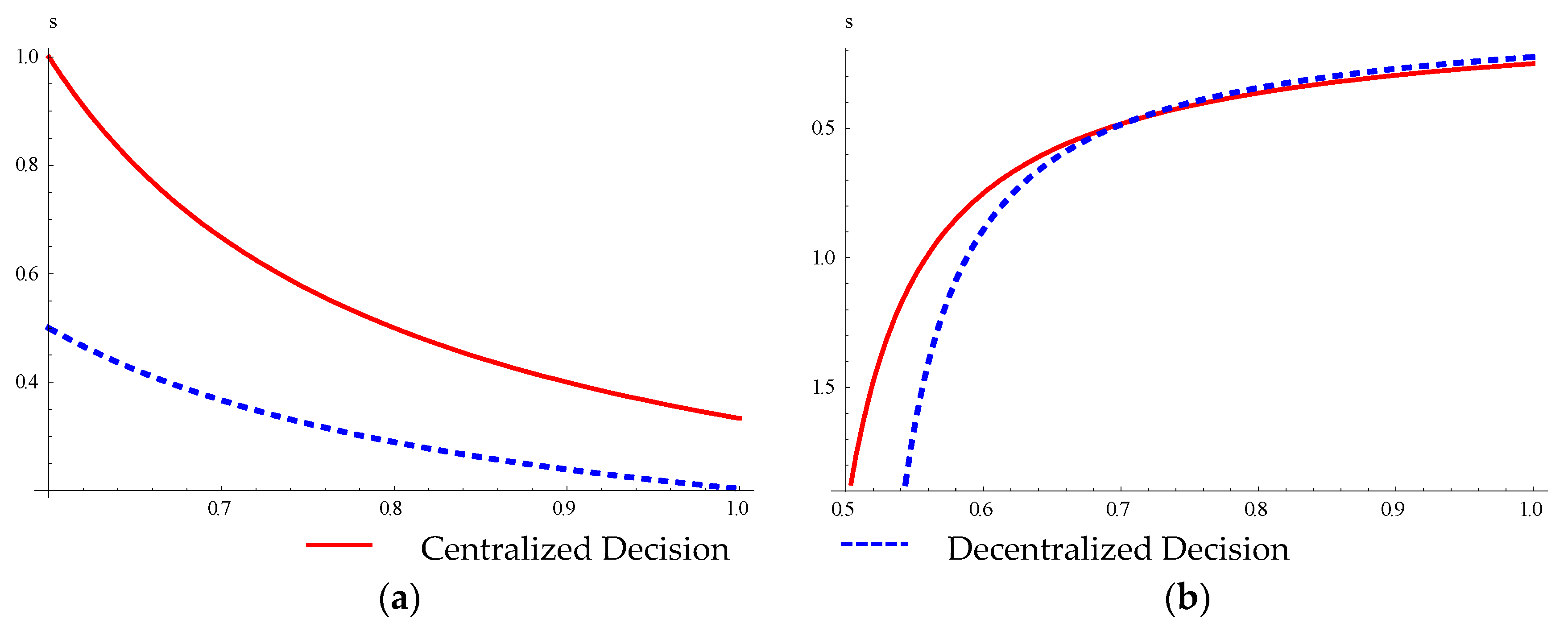
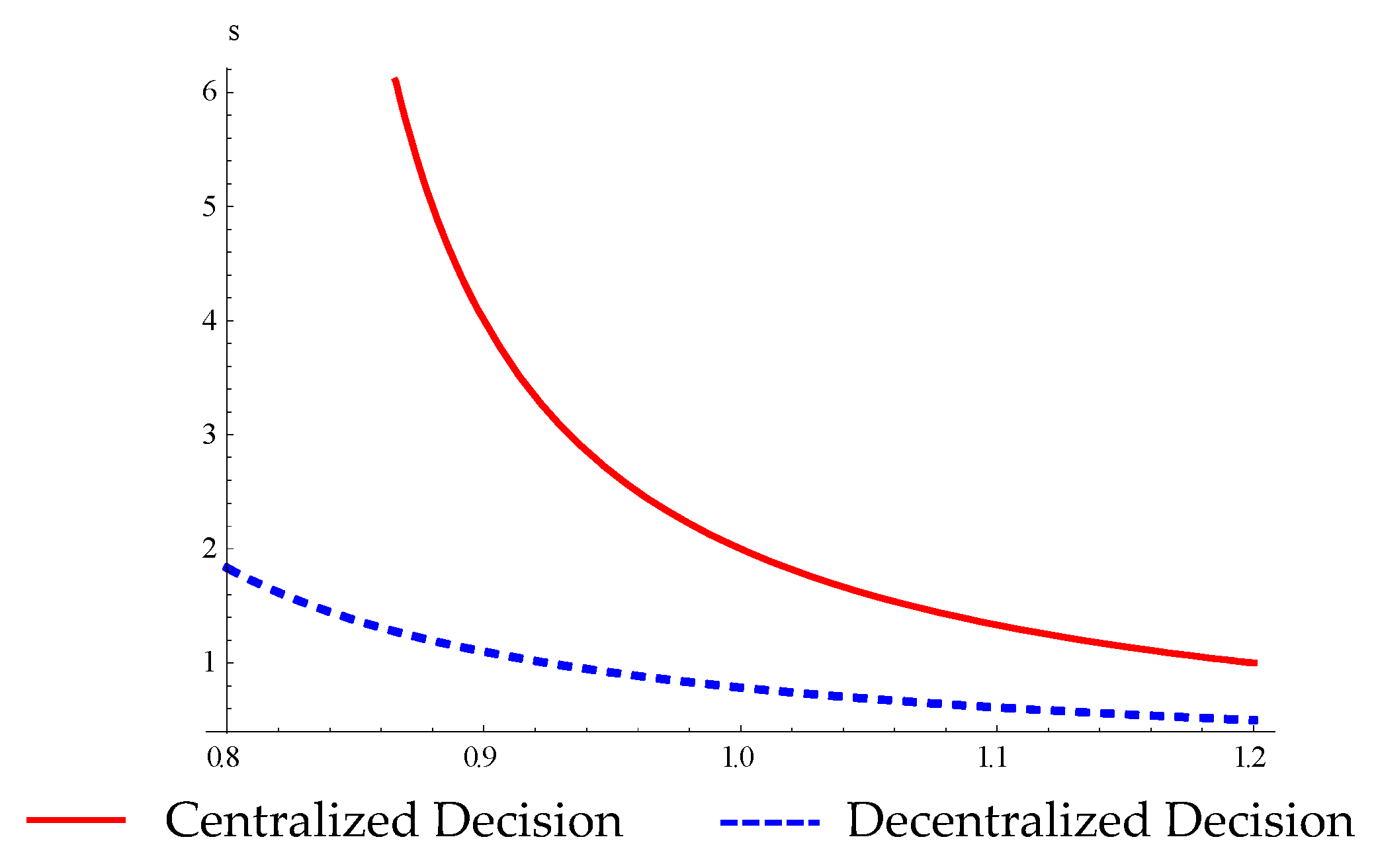
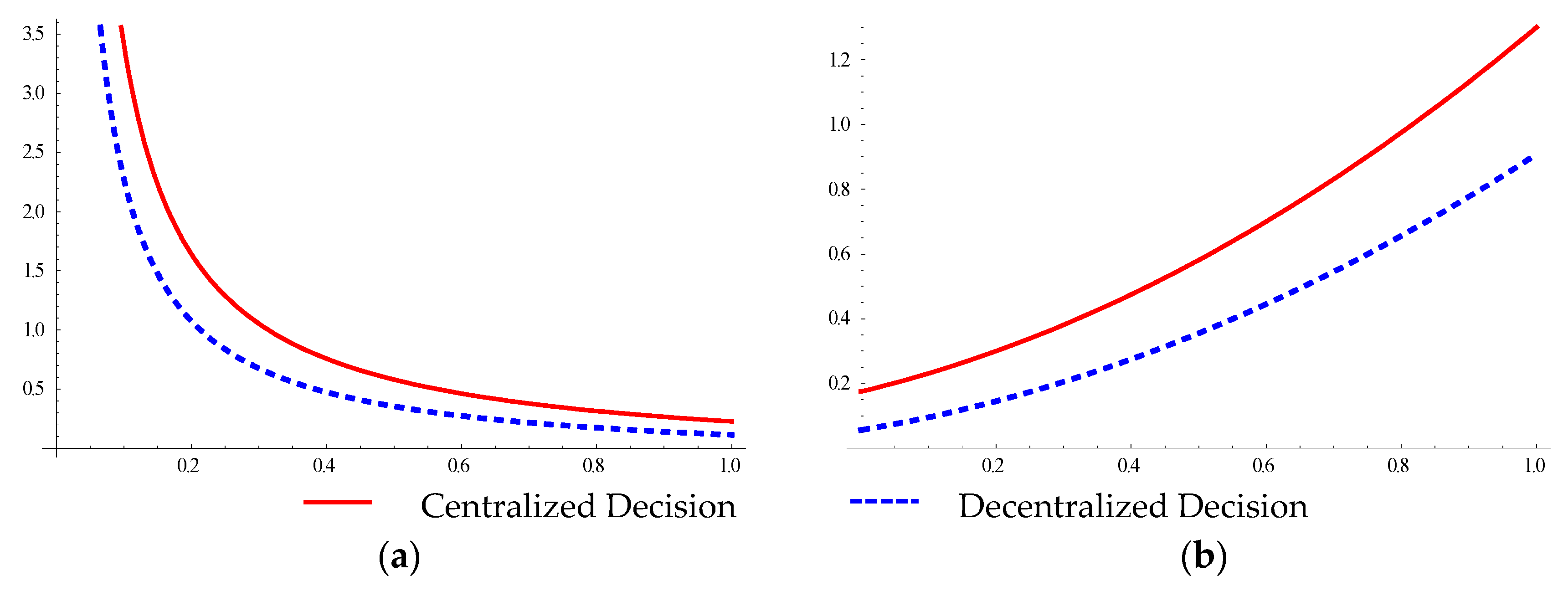


| Notation | Representation |
| pi | The product sale price. is the price in Merchant 1’s channel, is the price in Merchant 2’s channel. |
| λ | The basic product valuation of the consumer; . |
| si | The service level provided by the merchants. is the service level of Merchant 1; is the service level of Merchant 2. Merchant 1 can provide better services using IT, so . The service differentiation between the merchants is . |
| Ci | The service cost paid by the merchants. represents Merchant 1; represents Merchant 2. Referring to the definition of cost function in economic principles, . is the service cost coefficient, representing the efficiency of IT investment in converting service differentiation into cost. |
| δi | The channel preference (loyalty) of consumers. is the probability of purchasing from Merchant 1, is the probability of purchasing from Merchant 2; without loss of generality, assume . . |
| α | The consumer’s sensitivity to the product price;. |
| β | The consumer’s sensitivity to the service level; . |
| Di | The market demand function. is the market demand of Merchant 1, is the market demand of Merchant 2. |
| πi | The profit function. is the profit of Merchant 1, is the profit of Merchant 2. is the overall profit of the supply chain. |
| Ui | The consumer utility from product purchasing. is the utility of purchasing from Merchant 1, is the utility of purchasing from Merchant 2. |
Disclaimer/Publisher’s Note: The statements, opinions and data contained in all publications are solely those of the individual author(s) and contributor(s) and not of MDPI and/or the editor(s). MDPI and/or the editor(s) disclaim responsibility for any injury to people or property resulting from any ideas, methods, instructions or products referred to in the content. |
© 2025 by the authors. Published by MDPI on behalf of the International Institute of Knowledge Innovation and Invention. Licensee MDPI, Basel, Switzerland. This article is an open access article distributed under the terms and conditions of the Creative Commons Attribution (CC BY) license (https://creativecommons.org/licenses/by/4.0/).
Share and Cite
Ding, F.; Huo, J. Research on the Application Decision Making of Information Technology in the Sustainable Supply Chain of Cross-Border E-Commerce. Appl. Syst. Innov. 2025, 8, 69. https://doi.org/10.3390/asi8030069
Ding F, Huo J. Research on the Application Decision Making of Information Technology in the Sustainable Supply Chain of Cross-Border E-Commerce. Applied System Innovation. 2025; 8(3):69. https://doi.org/10.3390/asi8030069
Chicago/Turabian StyleDing, Feng, and Jiazhen Huo. 2025. "Research on the Application Decision Making of Information Technology in the Sustainable Supply Chain of Cross-Border E-Commerce" Applied System Innovation 8, no. 3: 69. https://doi.org/10.3390/asi8030069
APA StyleDing, F., & Huo, J. (2025). Research on the Application Decision Making of Information Technology in the Sustainable Supply Chain of Cross-Border E-Commerce. Applied System Innovation, 8(3), 69. https://doi.org/10.3390/asi8030069





